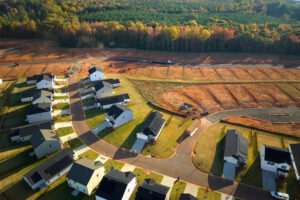 Data breaches, social media, new jobsite technologies—today’s construction risk landscape is vastly different than it was just six years ago, and all signs point to even more change in the future. Nearly half of construction contractors expect to see residential building disrupted within the next five years, while six in 10 anticipate more change in the construction industry than in the past 50 years.
Data breaches, social media, new jobsite technologies—today’s construction risk landscape is vastly different than it was just six years ago, and all signs point to even more change in the future. Nearly half of construction contractors expect to see residential building disrupted within the next five years, while six in 10 anticipate more change in the construction industry than in the past 50 years.
Home builder risk management practices must evolve to keep up.
“Gone are the days when risk management merely meant purchasing insurance policies and managing claims,” says Seth Hausman, managing director of Kraus-Anderson Risk Innovation. “Gone also are the days when risk registers and risk matrices enabled business leaders to feel comfortable that risks are managed and mitigated within the business. We are also past the time when businesses could rely only on three lines of defense (business management, risk oversight, internal audit) as sound risk management.”
The digital age demands a new approach to risk management across all industries, and construction is no exception. The pace of change is accelerating and digital crises move fast, so home builders need to become swift and nimble in response. Access to the latest regulatory requirements and risk management plans will be essential as contractors struggle to keep up with changing threats. And just in case a data breach or other incident occurs, builders need to embed within the risk management process a methodology for learning from the crisis and preventing future occurrences.
According to the AGC/FMI Risk Management Study, effective home builder risk management for the next decade will revolve around four key principles:
- Most risk is not insured
For years, insurance has been the linchpin around which most builder risk management strategies revolved. But that’s no longer enough, experts say. Many of the risks today’s home builders encounter are simply not insurable.
“Many business leaders equate risk management with insurance,” Hausman says. “Insured risks often include worker injury, automobile accidents, product failure and fire. It is true, the risks that are covered by insurance are part of a robust risk function; however, they only scratch the surface.”
It’s not the insured risks builders need to worry about, he adds—in fact, “almost all impact on a company’s profitability comes from risks that are not insured,” such as those residing within the organization’s people, processes, technology, and strategies. Drones, for example, are often excluded from a builder’s commercial general liability policy. While insurance and builder home warranty claim management should remain part of the bedrock of any risk management approach, builders need to focus at least as much time and attention on uninsured risks.
Home builder risk management is no longer the sole province of risk experts. Business leaders are getting involved as risk evaluation increasingly becomes integrated into daily strategic and operational decision-making. With the ability of social media and the 24-hour news cycle to amplify organizational failures, home builder reputation management has become inextricably intertwined with risk management.
In this unprecedented risk environment, more than nine in 10 contractors agree that collaboration reduces risk. Studies have found that the most effective risk evaluation and mitigation strategies—formal team brainstorming and regular team meetings, respectively—are collaborative in nature. Indeed, some experts have declared that increased collaboration at the outset of a project among all parties involved “seems destined to become the fundamental strategy for reducing risk in the future.”
Because the current practice of parceling out risks to specific parties in construction contracts discourages collaborative behavior, builders will need to rethink their approach, perhaps turning instead to shared risk and reward contracts.
- Risk evaluations should be quantitative
Today’s complex risk landscape demands more precision than ever before in assessing and prioritizing risks. This means builders can no longer rely on subjective or qualitative methods of risk evaluation. Data analysis offers a more precise and reliable means of understanding the likely impact on profitability, allowing builders to make more informed choices about how they manage risks.
- Compliance is just the beginning
As rapidly emerging technologies continue to disrupt business as usual, the laws and regulations governing their use are struggling to keep up. Once the end-all, be-all of home builder risk management, compliance has become a moving target, at best. While it remains a fundamental function of effective risk management, builders will need to look beyond legal and ethical compliance to mitigate the financial, operational and reputational risks of the digital age.
Collaborating with a trusted home builder warranty partner like PWSC can empower builders and take risk management to the next level. PWSC monitors legal and regulatory changes to help builders identify and mitigate emerging risks. With PWSC as a risk management partner, builders can gain new insight into the most common business risks of the digital age.





